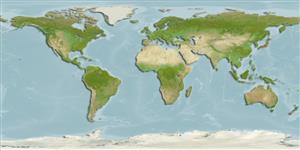>
Perciformes/Zoarcoidei (Eelpouts and pricklebacks) >
Zoarcidae (Eelpouts) > Lycodinae
Etymology: Lycenchelys: Greek, lykos = wolf + Greek, enchelys, -yos = eel (Ref. 45335); tohokuensis: Named for Tohoku National Fisheries Research Institute and the Tohoku coast of northern Honshu..
Environment: milieu / climate zone / depth range / distribution range
Ökologie
seewasser bathydemersal; tiefenbereich 543 - 709 m (Ref. 45048). Deep-water
Northwest Pacific: off Pacific coast of northern Japan.
Size / Gewicht / Alter
Maturity: Lm ? range ? - ? cm
Max length : 27.0 cm SL Männchen/unbestimmt; (Ref. 45048); 26.7 cm SL (female)
Kurzbeschreibung
Morphologie | Morphometrie
Rückenflossenstacheln (insgesamt): 0; Rückenflossenweichstrahlen (insgesamt): 111-114; Afterflossenstacheln 0; Afterflossenweichstrahlen: 93 - 94; Wirbelzahl: 116 - 119. Pelvic fins absent. Palatine teeth in 2 irregular rows anteriorly. Suborbital pores 5, emanating from lower ramus of bone chain. Postorbital pores 5. Head pores small, rounded (Ref. 45048).
Life cycle and mating behavior
Geschlechtsreife | Fortpflanzung | Ablaichen | Eier | Fecundity | Larven
Anderson, M.E. and H. Imamura, 2002. A new species of Lycenchelys (Perciformes: Zoarcidae) from the Pacific coast of northern Japan. Ichthyol. Res. 49(4):355-357. (Ref. 45048)
IUCN Rote Liste Status (Ref. 130435)
Bedrohung für Menschen
Harmless
Nutzung durch Menschen
Mehr Information
NamenSynonymeMetabolismusRäuberÖkotoxikologieFortpflanzungGeschlechtsreifeAblaichenSpawning aggregationFecundityEierEientwicklung
Alter/GrößeWachstumLänge-GewichtLänge-LängeLängenhäufigkeitenMorphometrieMorphologieLarvenLarven Pop.Dyn.RekrutierungDichteBRUVS
ReferenzenAquakulturAquakultur ProfilZuchtlinienGenetikElectrophoresesVererbbarkeitKrankheitenVerarbeitungNutrientsMass conversion
PartnerBilderStamps, Coins Misc.LauteCiguateraGeschwindigkeitSchwimmstilKiemenoberflächeOtolithsGehirngrößeSehfähigkeit
Tools
Zusatzinformationen
Download XML
Internet Quellen
Estimates based on models
Preferred temperature (Ref.
123201): 0.3 - 2.7, mean 0.3 °C (based on 5 cells).
Phylogenetic diversity index (Ref.
82804): PD
50 = 0.5000 [Uniqueness, from 0.5 = low to 2.0 = high].
Bayesian length-weight: a=0.00120 (0.00057 - 0.00252), b=3.10 (2.91 - 3.29), in cm total length, based on LWR estimates for this (Sub)family-body shape (Ref.
93245).
Trophic level (Ref.
69278): 3.4 ±0.5 se; based on size and trophs of closest relatives
Widerstandsfähigkeit (Ref.
120179): niedrig, Verdopplung der Population dauert 4,5 - 14 Jahre. (Preliminary K or Fecundity.).
Fishing Vulnerability (Ref.
59153): Low vulnerability (23 of 100).
